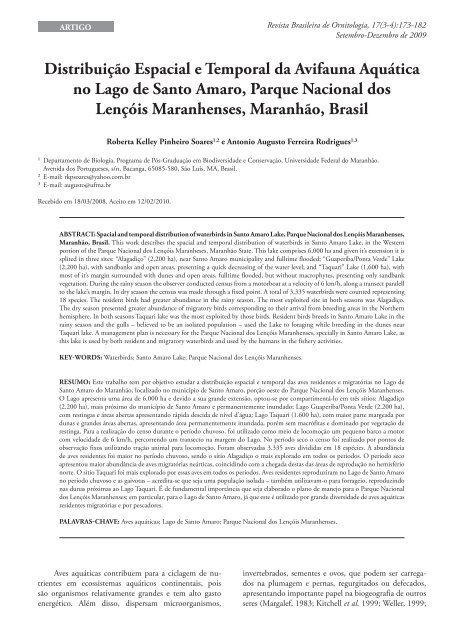art01 - yabe.indd - Sociedade Brasileira de Ornitologia
art01 - yabe.indd - Sociedade Brasileira de Ornitologia
art01 - yabe.indd - Sociedade Brasileira de Ornitologia
You also want an ePaper? Increase the reach of your titles
YUMPU automatically turns print PDFs into web optimized ePapers that Google loves.
ARTIGO Revista <strong>Brasileira</strong> <strong>de</strong> <strong>Ornitologia</strong>, 17(3-4):173-182<br />
Setembro-Dezembro <strong>de</strong> 2009<br />
Distribuição Espacial e Temporal da Avifauna Aquática<br />
no Lago <strong>de</strong> Santo Amaro, Parque Nacional dos<br />
Lençóis Maranhenses, Maranhão, Brasil<br />
Roberta Kelley Pinheiro Soares 1,2 e Antonio Augusto Ferreira Rodrigues 1,3<br />
1 Departamento <strong>de</strong> Biologia, Programa <strong>de</strong> Pós-Graduação em Biodiversida<strong>de</strong> e Conservação, Universida<strong>de</strong> Fe<strong>de</strong>ral do Maranhão.<br />
Avenida dos Portugueses, s/n, Bacanga, 65085‐580, São Luís, MA, Brasil.<br />
2 E‐mail: rkpsoares@yahoo.com.br<br />
3 E‐mail: augusto@ufma.br<br />
Recebido em 18/03/2008. Aceito em 12/02/2010.<br />
Abstract: Spacial and temporal distribution of waterbirds in Santo Amaro Lake, Parque Nacional dos Lençóis Maranhenses,<br />
Maranhão, Brasil. This work <strong>de</strong>scribes the spacial and temporal distribution of waterbirds in Santo Amaro Lake, in the Western<br />
portion of the Parque Nacional dos Lençóis Maranheses, Maranhão State. This lake comprises 6,000 ha and given it’s extension it is<br />
splited in three sites: “Alagadiço” (2,200 ha), near Santo Amaro municipality and fulltime floo<strong>de</strong>d; “Guaperiba/Ponta Ver<strong>de</strong>” Lake<br />
(2,200 ha), with sandbanks and open areas, presenting a quick <strong>de</strong>creasing of the water level; and “Taquari” Lake (1,600 ha), with<br />
most of it’s margin surroun<strong>de</strong>d with dunes and open areas, fulltime floo<strong>de</strong>d, but without macrophytes, presenting only sandbank<br />
vegetation. During the rainy season the observer conducted census from a motorboat at a velocity of 6 km/h, along a transect paralell<br />
to the lake’s margin. In dry season the census was ma<strong>de</strong> through a fixed point. A total of 3,335 waterbirds were counted representing<br />
18 species. The resi<strong>de</strong>nt birds had greater abundance in the rainy season. The most exploited site in both seasons was Alagadiço.<br />
The dry season presented greater abundance of migratory birds corresponding to their arrival from breeding areas in the Northern<br />
hemisphere. In both seasons Taquari lake was the most exploited by those birds. Resi<strong>de</strong>nt birds breeds in Santo Amaro Lake in the<br />
rainy season and the gulls – believed to be an isolated population – used the Lake to foraging while breeding in the dunes near<br />
Taquari lake. A management plan is necessary for the Parque Nacional dos Lençóis Maranhenses, specially in Santo Amaro Lake, as<br />
this lake is used by both resi<strong>de</strong>nt and migratory waterbirds and used by the humans in the fishery activities.<br />
Key-Words: Waterbirds; Santo Amaro Lake; Parque Nacional dos Lençóis Maranhenses.<br />
Resumo: Este trabalho tem por objetivo estudar a distribuição espacial e temporal das aves resi<strong>de</strong>ntes e migratórias no Lago <strong>de</strong><br />
Santo Amaro do Maranhão, localizado no município <strong>de</strong> Santo Amaro, porção oeste do Parque Nacional dos Lençóis Maranhenses.<br />
O Lago apresenta uma área <strong>de</strong> 6.000 ha e <strong>de</strong>vido a sua gran<strong>de</strong> extensão, optou-se por compartimentá-lo em três sítios: Alagadiço<br />
(2.200 ha), mais próximo do município <strong>de</strong> Santo Amaro e permanentemente inundado; Lago Guaperiba/Ponta Ver<strong>de</strong> (2.200 ha),<br />
com restingas e áreas abertas apresentando rápida <strong>de</strong>scida <strong>de</strong> nível d’água; Lago Taquari (1.600 ha), com maior parte margeada por<br />
dunas e gran<strong>de</strong>s áreas abertas, apresentando área permanentemente inundada, porém sem macrófitas e dominado por vegetação <strong>de</strong><br />
restinga. Para a realização do censo durante o período chuvoso, foi utilizado como meio <strong>de</strong> locomoção um pequeno barco a motor<br />
com velocida<strong>de</strong> <strong>de</strong> 6 km/h, percorrendo um transecto na margem do Lago. No período seco o censo foi realizado por pontos <strong>de</strong><br />
observação fixos utilizando tração animal para locomoção. Foram observadas 3.335 aves divididas em 18 espécies. A abundância<br />
<strong>de</strong> aves resi<strong>de</strong>ntes foi maior no período chuvoso, sendo o sítio Alagadiço o mais explorado em todos os períodos. O período seco<br />
apresentou maior abundância <strong>de</strong> aves migratórias neárticas, coincidindo com a chegada <strong>de</strong>stas das áreas <strong>de</strong> reprodução no hemisfério<br />
norte. O sítio Taquari foi mais explorado por essas aves em todos os períodos. Aves resi<strong>de</strong>ntes reproduziram no Lago <strong>de</strong> Santo Amaro<br />
no período chuvoso e as gaivotas – acredita-se que seja uma população isolada – também utilizavam-o para forrageio, reproduzindo<br />
nas dunas próximas ao Lago Taquari. É <strong>de</strong> fundamental importância que seja elaborado o plano <strong>de</strong> manejo para o Parque Nacional<br />
dos Lençóis Maranhenses; em particular, para o Lago <strong>de</strong> Santo Amaro, já que este é utilizado por gran<strong>de</strong> diversida<strong>de</strong> <strong>de</strong> aves aquáticas<br />
resi<strong>de</strong>ntes migratórias e por pescadores.<br />
Palavras-Chave: Aves aquáticas; Lago <strong>de</strong> Santo Amaro; Parque Nacional dos Lençóis Maranhenses.<br />
Aves aquáticas contribuem para a ciclagem <strong>de</strong> nutrientes<br />
em ecossistemas aquáticos continentais, pois<br />
são organismos relativamente gran<strong>de</strong>s e tem alto gasto<br />
energético. Além disso, dispersam microorganismos,<br />
invertebrados, sementes e ovos, que po<strong>de</strong>m ser carregados<br />
na plumagem e pernas, regurgitados ou <strong>de</strong>fecados,<br />
apresentando importante papel na biogeografia <strong>de</strong> outros<br />
seres (Margalef, 1983; Kitchell et al. 1999; Weller, 1999;

















